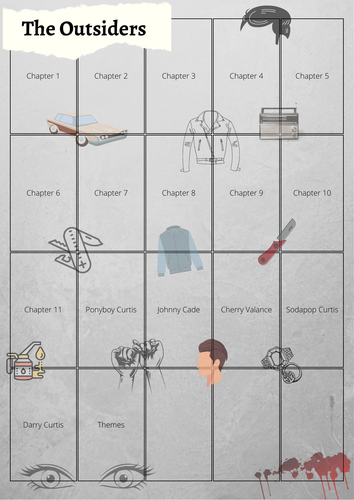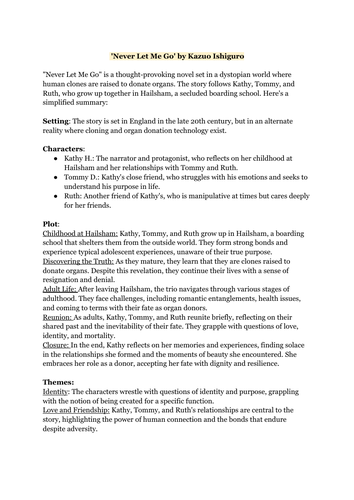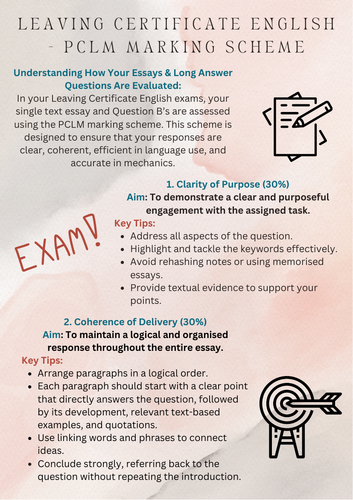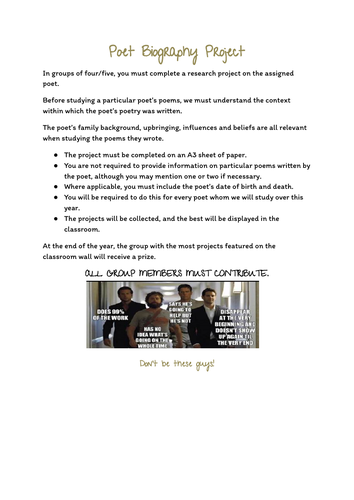
35Uploads
13k+Views
14k+Downloads
All resources

The Outsiders - Graphic Oraniser
Introducing the ideal companion for your classroom when exploring “The Outsiders” - our one-page graphic organiser! This meticulously crafted A3 chart is designed with both students and teachers in mind, catering to the needs of educators like you who are passionate about teaching English.
This comprehensive graphic organiser is a valuable tool for dissecting S.E. Hinton’s classic novel. It’s ingeniously structured, with a dedicated box for each chapter, enabling students to record key events, character developments, and central themes as they read. What sets it apart is its adaptability, offering three flexible boxes for teachers to customise – whether for novel feedback, concise reviews, or memorable quotes from the text.
But that’s not all; we’ve incorporated captivating images and symbols related to ‘The Outsiders’ into the design, enhancing visual engagement and aiding memory retention. Hang it proudly on your classroom wall, turning it into an attractive and informative centerpiece for your students.
As an English teacher, you understand the value of visual aids and organised note-taking, and this graphic organiser is your perfect ally in the teaching journey. It will guide your students through the novel’s intricate narrative, making their learning experience not only more engaging but also more effective. So why wait? Elevate your “The Outsiders” lessons with this indispensable tool today.

Literary techniques Quiz
This resource is a valuable toolkit for English teachers, designed to enhance their teaching of literary devices and language elements to students of various levels. It includes two meticulously crafted tests, each catering to different levels of proficiency. Additionally, answer keys are provided for easy grading. The PowerPoint presentation, which complements the tests, is available for separate purchase or can be bundled with this resource.
Features of the Resource:
Differentiated Tests: The package consists of two tests, carefully tailored to meet the needs of students at different levels of proficiency. This allows teachers to choose the most suitable test for their class, whether they are teaching beginners or advanced students.
Comprehensive Coverage: The tests cover a wide range of essential literary devices and language elements, ensuring that students are exposed to key concepts fundamental to English language and literature. These include hyperbole, imagery, alliteration, metaphor, personification, rhyme, rhetorical questions, and theme.
Answer Keys: For each test, detailed answer keys are provided, making grading efficient and straightforward.
Flexible PowerPoint Option: The PowerPoint presentation, which complements the tests, can be purchased separately or as part of a convenient bundle. It features visual aids, examples, and explanations to support teachers in delivering engaging lessons on each topic covered in the tests.
Versatile Usage: Whether used as pre-assessment tools to gauge students’ prior knowledge, as formative assessments to track their progress, or as summative evaluations to measure their mastery of literary devices, these tests offer versatility to teachers.
Time-Saving and Convenient: As a ready-made resource, this package saves teachers valuable time that would otherwise be spent creating assessments from scratch.
Engaging Learning Experience: The combination of tests and a visually appealing PowerPoint presentation ensures that students remain engaged while learning about these important literary concepts.

2017 - Question B - Sample Answer
QUESTION B
**Your school Principal has agreed to your suggestion to display three poems, or extracts from three poems, on the 2017 Leaving Certificate Higher Level English poetry course, in your school. You have been asked to choose the poetry and decide how and where it will be displayed. Write an article for your school’s website in which you explain your choice of poetry, your ideas for its display and the impact you hope this project will have on the school community. (50)

Once - Graphic Organiser
Introducing the perfect companion for your classroom as you delve into Morris Gleitzman’s heartwarming novel, “Once” – our one-page graphic organiser! Designed with the needs of both students and educators in mind, this A3 chart is a fantastic addition to any English teacher’s toolkit.
This meticulously crafted graphic organiser offers a unique, chapter-by-chapter breakdown of the novel. With dedicated boxes for each chapter and key characters, it allows students to comprehensively document the journey of Felix, the young protagonist, as he navigates a world filled with challenges, hope, and resilience.
But what sets our graphic organiser apart is the inclusion of captivating images and symbols that are directly related to the novel. These visual cues not only enhance comprehension but also make the learning experience more engaging and memorable.
Picture this: as you guide your students through “Once,” they’ll be able to visually connect with the story’s themes and characters right there on your classroom wall. It’s a powerful tool for sparking discussion, enhancing critical thinking, and encouraging a deeper understanding of the narrative.
As an English teacher, you know the value of well-organised teaching aids, and this graphic organiser is your key to making “Once” come alive in your classroom. Don’t miss out on the opportunity to enrich your students’ literary journey with this visually captivating resource. Order it today and let Felix’s unforgettable story unfold right before your students’ eyes!

Junior Cycle Poetry
The Comprehensive Junior Cycle Poetry Teacher’s Guide
This comprehensive guide provides teachers with all the resources they need to effectively teach junior cycle poetry. It includes:
A detailed breakdown of 21 essential poetry terms, covering both basic and advanced concepts. Each term is explained clearly and concisely, with examples to illustrate its usage.
A step-by-step guide to approaching unseen poems, empowering teachers to equip their students with the skills to analyze unfamiliar pieces.
Line-by-line analysis, summaries, and junior cycle past sample answers for 11 poems from a variety of authors, including Mid-term Break, Digging, and If–. These resources provide teachers with a solid foundation for teaching these poems and help students understand their deeper meanings.
Key Features:
Comprehensive coverage of essential poetry terms
Practical strategies for approaching unseen poems
In-depth analysis of 11 selected poems
A wealth of sample student answers
Benefits:
Enhance your understanding of poetry analysis and teaching methods
Empower your students to confidently tackle unseen poetry questions
Deepen your students’ appreciation of a variety of poetry styles and themes
This teacher’s guide is an invaluable resource for educators seeking to enrich their junior cycle poetry lessons and ensure their students’ success in this challenging yet rewarding area of study.

Never Let Me Go - Relationships, Social Setting and Hero, Heroine, Villain
Description:
These study notes provide a comprehensive analysis of Kazuo Ishiguro’s novel “Never Let Me Go,” focusing on the ordinary level comparative modes. Designed for students and teachers alike, these notes offer an in-depth exploration of the novel’s themes, characters and relationships.
Key Components:
Summary of the Novel: The notes begin with a simplified summary of the novel, outlining the main plot points and character arcs in a concise manner.
Character Analysis: Detailed profiles of the main characters, including Kathy, Tommy, and Ruth, explore their motivations, relationships, and development throughout the story.
Themes and Motifs: Thematic analysis delves into the novel’s exploration of identity, friendship, mortality, and societal norms, examining how these themes are developed and interconnected.
Plot Overview: A breakdown of the novel’s structure and key events provides readers with a chronological understanding of the narrative trajectory, highlighting pivotal moments and turning points.
Overall, these study notes serve as a valuable resource for readers seeking to deepen their understanding and appreciation of “Never Let Me Go,” offering a comprehensive analysis that illuminates the novel’s themes, characters, and socio-cultural context. Whether used for independent study or as a teaching aid in the classroom, these notes provide invaluable insights into Ishiguro’s masterful exploration of the human condition in a dystopian world.

Leaving Certificate English - PCLM Marking Scheme
This two-page worksheet breaks down the PCLM marking scheme into easily digestible insights, helping you understand how your essays are assessed.

Tips for Effective Question B Presentation
Description:
This resource comprises ten informative slides designed to help Leaving Certificate students effectively approach Question B on their exam paper. Question B is a critical component of the examination, and this resource offers a concise yet comprehensive overview of how to tackle it successfully.

Introduction to OL English
An introduction to the OL English course for 5th year students and a guide on what texts to purchase and where.
Follow @rescueresource on instagram for an editable version of this resource!

Louder than Words - First Year Scheme of Work
This scheme of work covers the academic year and includes a diverse range of texts and activities to engage and develop students’ language skills. It encompasses poetry, drama, novels, short stories, oral texts, and written communication. The curriculum aims to enhance critical thinking, language proficiency, and a deep appreciation for literature and communication skills. It is divided into thematic units with specific learning outcomes and assessments.

Poetry Biography Project
"Poet Biography Project: Understanding the Poet’s World
This engaging project invites students to delve into the lives and backgrounds of renowned poets, gaining valuable insights into the context that shaped their poetry. Working in groups of four or five, students are tasked with researching an assigned poet and presenting their findings on an A3 sheet of paper.
Key Objectives:
Contextual Understanding: Explore the poet’s family background, upbringing, influences, and beliefs to comprehend the environment in which their poetry evolved.
Biographical Details: Include the poet’s birth and death dates where applicable.
Fostering Research Skills: Encourage students to conduct thorough research to create informative presentations.
Classroom Display: Projects will be collected, with the best ones featured prominently in the classroom.
Friendly Competition: Students will have the chance to compete, and the group with the most projects displayed at the end of the year will receive a prize.
This resource not only enhances students’ knowledge of poetry but also cultivates research and presentation skills. It offers an exciting opportunity for creative exploration and deeper comprehension of the poets whose work they’ll encounter throughout the year."

John Donne - Ordinary Level - Class Test
This resource is a “Weekly Test” for the study of John Donne’s poems, specifically focusing on “Go and Catch a Falling Star” and “The Flea.” It is designed for students, particularly those preparing for Irish Leaving Certificate at Ordinary Level. The test consists of a series of structured questions that encourage critical thinking and analysis of these two poems.
For “Go and Catch a Falling Star,” students are asked to describe the fantastical elements in the poem and analyze their symbolism. They also explore the speaker’s attitude towards love and relationships, the significance of a repeated line, and the speaker’s view of honesty in women.
For “The Flea,” students examine the central metaphor and how it is used for persuasion, the symbolism of the flea in the lovers’ relationship, the speaker’s feelings about physical intimacy, and the significance of a specific line. Additionally, they are prompted to share their impression of the speaker based on their reading of the poem.
The test provides a total score out of 60 and includes space for a parent’s signature, indicating its suitability for classroom use or as a practice resource for students preparing for their exams.

Little Women - 2019 - Greta Gerwig - Student Workbook & Revision Notes
Delve into the world of Greta Gerwig’s captivating creation with this meticulously crafted study guide. Designed for both students and educators, this resource offers a thorough exploration of the narrative, themes, characters, and cinematic techniques employed by Gerwig. From pre-reading activities to critical thinking questions, this guide is tailored to enhance understanding and engagement with the material.
Contents:
Plot Overview: A concise summary of the storyline to provide context.
Pre-reading Activities: Engaging exercises to prepare students for the themes and concepts explored in the work.
Camera Angles Guide: Analysis of the techniques typically used in film.
Notes on Setting: Detailed insights into the significance of the setting and its impact on the narrative.
Key Characters: Profiles of the main characters, including their motivations and development throughout the story.
Comprehension Questions: Watch and Write questions for students to answers upon a second viewing.
Critical Thinking Questions: Prompts to encourage deeper analysis and interpretation.
Detailed Summary: A comprehensive breakdown of key plot points and developments.
Key Moments: Highlighting pivotal scenes and their significance.
Key Quotes: Extracts from the film accompanied by analysis of their thematic relevance.
Themes: Exploration of the major themes explored in the film and their broader implications.
Sample Exam Questions: Higher and Ordinary level questions for the Junior Cycle exams, with model answers provided.
QR Code to Quizlet & Quizzizz Link: Convenient access to online study resources for further practice and review.
Answer Key: Solutions to comprehension questions for self-assessment and feedback.

Ordinary Level Comparative Revision - Where the Crawdads Sing and The Shawshank Redemption
This comprehensive 36-page document delves into a detailed comparison of two prominent texts featured in the Leaving Certificate comparison course: “The Shawshank Redemption” by Frank Darabont and “Where the Crawdads Sing” by Delia Owens. Focused on the thematic elements of Isolation and the dynamic portrayal of Hero, Heroine, and Villain, this resource provides an in-depth exploration of both texts, offering valuable insights for students and teachers alike.
Content Highlights:
Thematic Comparison: Explores the theme of Isolation in both texts, dissecting how this theme is depicted, its significance, and its impact on characters and narrative development.
Character Analysis: Provides comprehensive character notes for key figures in each text, shedding light on their motivations, complexities, and roles within the themes of Isolation and Hero, Heroine, Villain.
Key Moments Examination: Breaks down pivotal moments in both texts, highlighting scenes that intricately illustrate themes of Isolation and the portrayal of heroic, villainous, and protagonist characters.
Quotations Analysis: Presents key quotes from the texts, analysing their contextual significance, thematic relevance, and how they contribute to character development and storytelling.
Sample Answers: Offers sample answers to exemplify how to structure responses, drawing comparisons between the texts based on the themes and characters explored.
Benefits for Students and Teachers:
Comprehensive Analysis: Provides an in-depth study of themes and characters in both texts, aiding a thorough understanding for students preparing for exams.
Educational Guidance: Offers teachers a valuable resource for structuring lesson plans and guiding students through comparative analysis.
Exam Preparation: Equips students with valuable insights, character notes, and sample answers to enhance their exam preparation and essay writing skills.
This resource serves as an invaluable tool for those studying and teaching the Leaving Certificate comparative course, offering a detailed exploration of thematic elements and character dynamics across two compelling texts.**

Merchant of Venice class test and Revision Notes
*EDITED Apologies! Notes were created using an inaccurate version so there were three errors that have been noted and corrected! Apologies!
*
Class test (1hr class)
The test comprises five sections, each addressing specific aspects of William Shakespeare’s play “The Merchant of Venice.”
Section 1: Plot Structure
Requires identifying the key components of Freytag’s Pyramid (Exposition, Rising Action, Climax, Falling Action, Denouement) within the play. Specific examples from the text are requested to support the identification of each component.
Section 2: Character Relationships
Focuses on the relationship between Antonio and Shylock, inquiring how this relationship contributes to the overall conflict in the play. A separate question explores the impact of the friendship between Bassanio and Antonio on the plot and characters.
Section 3: Tension in a Scene
Asks for an analysis of the scene with the most tension in the play. The student is prompted to describe the setting, characters involved, factors contributing to the tension, and how the tension is ultimately resolved within that scene.
Section 4: Themes
Explores the themes of mercy and justice in the play. It asks for examples of characters or scenes embodying these themes and how they contribute to the overall message of the play. Another question addresses the impact of prejudice on Shylock and his interactions with others.
Section 5: Key Plot Details
Examines the significance of the casket test within the play, focusing on its impact on the plot and characters. Another question prompts students to recall the events leading up to the courtroom scene and analyze how the trial affects the characters and resolves the play’s conflicts.
Overall, the test aims to evaluate students’ understanding of the plot structure, character relationships, thematic elements, and significant plot details within “The Merchant of Venice.” Students are required to provide specific examples and detailed explanations to demonstrate their comprehension of the play’s nuances and themes.
Revision Notes Document:
The revision notes serve as a study guide summarising essential themes, character dynamics, key scenes, and their significance within the play.
It explores and analyses various elements, including the relationship between Antonio and Shylock, the impact of friendship between Bassanio and Antonio, themes of mercy and justice, the concept of prejudice and its effects on Shylock, the significance of the casket test, and the pivotal courtroom scene.
Both documents collectively provide a comprehensive resource for students preparing for the Junior Certificate exam. The test offers a structured way to assess students’ understanding of the play’s narrative structure, while the revision notes consolidate key themes, character relationships, and significant scenes, aiding in a deeper understanding and analysis of the text.















